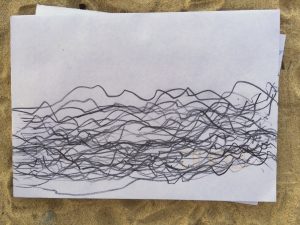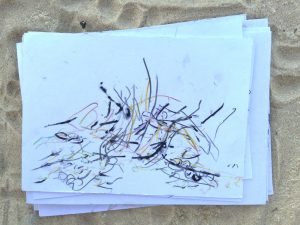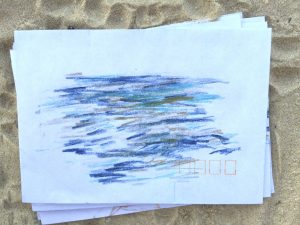I am visiting the coast, this provides a great opportunity to walk and explore where the sea and beach create a shoreline. I decide to walk along this shoreline each day to see what I notice and to think about the walking playground in this new space.
It is easy to be inspired. The shoreline is teeming with interesting things: as I walk I look up into the sky, look down at the sand and what may be strewn there. I look out across the watery horizon at birds, boats, rocks and distant hills. Thoughts about scale come easily, as well as movement and the tricky, shifting edges between things. As I walk this coast’line’ I watch the sea and think about its capacity to solidly occupy the space beyond the beach, its capacity to hold objects and creatures, its capacity to reduce and minimise as it edges inland as well as gather itself up, retreat and swell and boom and crash.
I pause to draw some of these thoughts, and as I draw it occurs to me that there are three really important aspects to the place I’m in. The enjoyment of being at the beach is not just about the sand, the water, the rocks, the creatures and so on. There are other aspects that are not ‘physical’ but take on a materiality and affective significance. Movement is one, in the micro scale of sand grains as they are drawn into the sea as the waves recede, or in the ginormous pulsing tides. Light is another, and dark (or the absence of light, or the effect of greater mass density) is another. These aspects take on a materiality because they are crucial for seeing how water forms and shifts, the exposure of rock through waves, the glare of sun, the movement of sand grains. Light, dark, and movement help map the coastline and its playful contents.
I decided to hold with the theme of the beach: instead of my usual mapping process I created drawings of dark, light, movements, and edges on postcards and sent them out to friends across the globe. 

